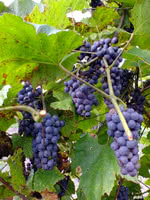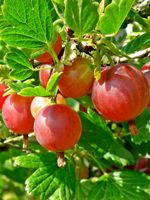Mon-Fri 9am - 5pm Mountain time
Amur Grape vs Sebastien Gooseberry
Vitis amurensis
Ribes uva-crispa Sebastien
NOT AVAILABLE THIS SEASON - MIGHT RETURN
NOT AVAILABLE THIS SEASON - MIGHT RETURN
(new stock expected: fall of 2026)
The Amur Grape is an ornamental grape that fruits dark, sour, juicy grapes later in the fall. It is native to Asia, and found growing wild in Russia and China. It’s one of the most cold-hardy grape varieties, prized for its foliage that turns from a bright green to a deep crimson and purple in the fall. The flowers are small and white, usually appearing in the beginning of May.
The name for the Amur Grape comes from the Amur Valley, located in Russia. It’s extremely resistant to frost. The berries are good for fresh eating, but also make a flavorful addition to any homemade wines and preserves. The leaves are also edible, and are commonly used in salads. This plant does best with a trellis.
Note: We do not ship grape vines to BC due to regulatory restrictions from the Canadian Food Inspection Agency.
Sebastien Gooseberry is a nearly thornless variety that produces medium-sized, red gooseberries. When the berries are fully ripe they are quite sweet and great for fresh eating. They can be stored for up to two weeks in the fridge. For baking and preserves, they are often picked when under-ripe when they are firm and tart. The general harvest period is anywhere from July to September.
Sebastien Gooseberry is a Canadian variety that was developed at the Agriculture and Agri-Food Canada research station in Ottawa.
Gooseberries are self-pollinating but planting with another variety will increase yields.
Amur Grape Quick Facts
Sebastien Gooseberry Quick Facts
Toxicity: leaves are toxic to humans

